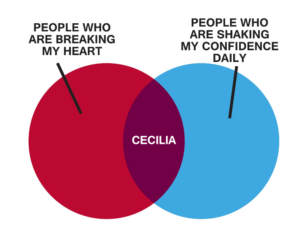Learning Objectives
- Use interval notation to describe intersections and unions
- Use graphs to describe intersections and unions
- Solve compound inequalities in the form of or and express the solution graphically and with an interval
- Express solutions to inequalities graphically and with interval notation
- Identify solutions for compound inequalities in the form [latex]a
- Solve single- and multi-step inequalities containing absolute values
- Identify cases where there are no solutions to absolute value inequalities
Many times, solutions to inequalities lie between two quantities, rather than continuing endlessly in one direction. Your blood pressure reading is one example of this. When you go to the doctor, the nurse takes your blood pressure reading. Blood pressure measures the pressure of blood in the circulatory system, and is composed of two numbers, systolic and diastolic. When the nurse takes your blood pressure, he is looking to see what range your blood pressure falls into. For example, systolic (top number) blood pressure that is between 120 and 139 mm Hg is called borderline high blood pressure. This can be described using a compound inequality, [latex]b<139[/latex] and [latex]b>120[/latex]. In this section we will explore how to solve compound inequalities and represent solutions using standard conventions.
Use interval notation to describe sets of numbers as intersections and unions
When two inequalities are joined by the word and, the solution of the compound inequality occurs when both inequalities are true at the same time. It is the overlap, or intersection, of the solutions for each inequality. When the two inequalities are joined by the word or, the solution of the compound inequality occurs when either of the inequalities is true. The solution is the combination, or union, of the two individual solutions.
In this section we will learn how to solve compound inequalities that are joined with the words AND and OR. First, it will help to see some examples of inequalities, intervals, and graphs of compound inequalities. This will help you describe the solutions to compound inequalities properly.
Venn diagrams use the concept of intersections and unions to show how much two or more things share in common. For example, this Venn diagram shows the intersection of people who are breaking your heart and those who are shaking your confidence daily. Apparently Cecilia has both of these qualities; therefore she is the intersection of the two.

In mathematical terms, consider the inequality [latex]x\lt6[/latex] and [latex]x\gt2[/latex]. How would we interpret what numbers x can be, and what would the interval look like?
In words, x must be less than 6 and at the same time, it must be greater than 2, much like the Venn diagram above, where Cecilia is at once breaking your heart and shaking your confidence daily. Let’s look at a graph to see what numbers are possible with these constraints.

The numbers that are shared by both lines on the graph are called the intersection of the two inequalities [latex]x\lt6[/latex] and [latex]x\gt2[/latex]. This is called a bounded inequality and is written as [latex]2\lt{x}\lt6[/latex]. Think about that one for a minute. x must be less than 6 and greater than two—the values for x will fall between two numbers. In interval notation, this looks like [latex]\left(2,6\right)[/latex]. The graph would look like this:
 On the other hand, if you need to represent two things that don’t share any common elements or traits, you can use a union. The following Venn diagram shows two things that share no similar traits or elements but are often considered in the same application, such as online shopping or banking.
On the other hand, if you need to represent two things that don’t share any common elements or traits, you can use a union. The following Venn diagram shows two things that share no similar traits or elements but are often considered in the same application, such as online shopping or banking.

In mathematical terms, for example, [latex]x>6[/latex] or [latex]x<2[/latex] is an inequality joined by the word or. Using interval notation, we can describe each of these inequalities separately:
[latex]x\gt6[/latex] is the same as [latex]\left(6, \infty\right)[/latex] and [latex]x<2[/latex] is the same as [latex]\left(\infty, 2\right)[/latex]. If we are describing solutions to inequalities, what effect does the or have? We are saying that solutions are either real numbers less than two or real numbers greater than 6. Can you see why we need to write them as two separate intervals? Let’s look at a graph to get a clear picture of what is going on.

When you place both of these inequalities on a graph, we can see that they share no numbers in common. This is what we call a union, as mentioned above. The interval notation associated with a union is a big U, so instead of writing or, we join our intervals with a big U, like this:
[latex]\left(\infty, 2\right)\cup\left(6, \infty\right)[/latex]
It is common convention to construct intervals starting with the value that is furthest left on the number line as the left value, such as [latex]\left(2,6\right)[/latex], where 2 is less than 6. The number on the right should be greater than the number on the left.
Example
Draw the graph of the compound inequality [latex]x\gt3[/latex] or [latex]x\le4[/latex] and describe the set of x-values that will satisfy it with an interval.
In the following video you will see two examples of how to express inequalities involving OR graphically and as an interval.
Examples
Draw a graph of the compound inequality: [latex]x\lt5[/latex] and [latex]x\ge−1[/latex], and describe the set of x-values that will satisfy it with an interval.
Examples
Draw the graph of the compound inequality [latex]x\lt{-3}[/latex] and [latex]x\gt{3}[/latex], and describe the set of x-values that will satisfy it with an interval.
The following video presents two examples of how to draw inequalities involving AND, as well as write the corresponding intervals.
Solve compound inequalities in the form of or
As we saw in the last section, the solution of a compound inequality that consists of two inequalities joined with the word or is the union of the solutions of each inequality. Unions allow us to create a new set from two that may or may not have elements in common.
In this section you will see that some inequalities need to be simplified before their solution can be written or graphed.
In the following example, you will see an example of how to solve a one-step inequality in the OR form. Note how each inequality is treated independently until the end where the solution is described in terms of both inequalities. You will use the same properties to solve compound inequalities that you used to solve regular inequalities.
Example
Solve for x. [latex]3x–1<8[/latex] or [latex]x–5>0[/latex]
Remember to apply the properties of inequality when you are solving compound inequalities. The next example involves dividing by a negative to isolate a variable.
Example
Solve for y. [latex]2y+7\lt13\text{ or }−3y–2\lt10[/latex]
In the last example, the final answer included solutions whose intervals overlapped, causing the answer to include all the numbers on the number line. In words, we call this solution “all real numbers.” Any real number will produce a true statement for either [latex]y<3\text{ or }y\ge -4[/latex], when it is substituted for x.
Example
Solve for z. [latex]5z–3\gt−18[/latex] or [latex]−2z–1\gt15[/latex]
The following video contains an example of solving a compound inequality involving OR, and drawing the associated graph.
In the next section you will see examples of how to solve compound inequalities containing and.
Solve compound inequalities in the form of and and express the solution graphically
The solution of a compound inequality that consists of two inequalities joined with the word and is the intersection of the solutions of each inequality. In other words, both statements must be true at the same time. The solution to an and compound inequality are all the solutions that the two inequalities have in common. As we saw in the last sections, this is where the two graphs overlap.
In this section we will see more examples where we have to simplify the compound inequalities before we can express their solutions graphically or with an interval.
Example
Solve for x. [latex]\displaystyle 1-4x\le 21\,\,\,\,\text{and}\,\,\,\,5x+2\ge22[/latex]
Example
Solve for x: [latex]\displaystyle {5}{x}-{2}\le{3}\text{ and }{4}{x}{+7}>{3}[/latex]
Compound inequalities in the form [latex]a
Rather than splitting a compound inequality in the form of [latex]a and [latex]x>a[/latex], you can more quickly to solve the inequality by applying the properties of inequality to all three segments of the compound inequality.
Example
Solve for x. [latex]3\lt2x+3\leq 7[/latex]
Show Solution
In the video below, you will see another example of how to solve an inequality in the form [latex]a
Example 8: Solving a Compound Inequality with the Variable in All Three Parts
Solve the compound inequality with variables in all three parts: [latex]3+x>7x - 2>5x - 10[/latex].
Solution
Lets try the first method. Write two inequalities:
[latex]\begin{array}{lll}3+x> 7x - 2\hfill & \text{and}\hfill & 7x - 2> 5x - 10\hfill \\ 3> 6x - 2\hfill & \hfill & 2x - 2> -10\hfill \\ 5> 6x\hfill & \hfill & 2x> -8\hfill \\ \frac{5}{6}> x\hfill & \hfill & x> -4\hfill \\ x< \frac{5}{6}\hfill & \hfill & -4< x\hfill \end{array}[/latex]
The solution set is [latex]-4
Figure 3
Rather than splitting a compound inequality in the form of [latex]a
Example
Solve for x. [latex]3\lt2x+3\leq 7[/latex]
In the video below, you will see another example of how to solve an inequality in the form [latex]a
Example 8: Solving a Compound Inequality with the Variable in All Three Parts
Solve the compound inequality with variables in all three parts: [latex]3+x>7x - 2>5x - 10[/latex].
Solution
Lets try the first method. Write two inequalities:
The solution set is [latex]-4
Figure 3




















